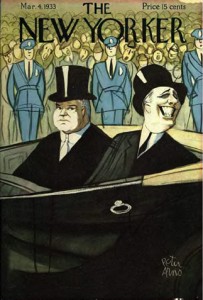Overview
 When Franklin Roosevelt took the oath of office as president on March 4, 1933, the nation’s economic crisis had become the most severe in its history. Not only was unemployment rising and poverty widespread, but the banking system appeared to be in a state of near collapse. Over nine thousand banks had failed since 1929. President Roosevelt then initiated a period of unprecedented federal government activity, including dramatic executive action (such as temporarily closing banks) and a flurry of legislative proposals coordinated closely with a Democratic-controlled Congress. The result was fifteen major pieces of domestic legislation signed into law by June 1933, a remarkable period known as the Hundred Days. Subsequently, the Roosevelt administration and the its allies in Congress pushed through a series of additional reforms This “New Deal” involved a much larger role for the federal government in the American economy. These changes, such as the Wagner Act and the Social Security Act, provoked fierce opposition –from conservatives in Congress and on the Supreme Court and also from some left-wing critics, such as Louisiana Democrat Huey Long, who attacked FDR for not going far enough. Yet despite all of this opposition, Roosevelt won a landslide reelection in 1936. The New Deal never quite succeeded in defeating the Great Depression –only the mobilization of World War II would finally succeed in doing that– but Roosevelt’s efforts had a profound effect on the regulatory role of the federal government and on the domestic agenda-setting power of the American president.
When Franklin Roosevelt took the oath of office as president on March 4, 1933, the nation’s economic crisis had become the most severe in its history. Not only was unemployment rising and poverty widespread, but the banking system appeared to be in a state of near collapse. Over nine thousand banks had failed since 1929. President Roosevelt then initiated a period of unprecedented federal government activity, including dramatic executive action (such as temporarily closing banks) and a flurry of legislative proposals coordinated closely with a Democratic-controlled Congress. The result was fifteen major pieces of domestic legislation signed into law by June 1933, a remarkable period known as the Hundred Days. Subsequently, the Roosevelt administration and the its allies in Congress pushed through a series of additional reforms This “New Deal” involved a much larger role for the federal government in the American economy. These changes, such as the Wagner Act and the Social Security Act, provoked fierce opposition –from conservatives in Congress and on the Supreme Court and also from some left-wing critics, such as Louisiana Democrat Huey Long, who attacked FDR for not going far enough. Yet despite all of this opposition, Roosevelt won a landslide reelection in 1936. The New Deal never quite succeeded in defeating the Great Depression –only the mobilization of World War II would finally succeed in doing that– but Roosevelt’s efforts had a profound effect on the regulatory role of the federal government and on the domestic agenda-setting power of the American president.
Online Textbook Resources
1930s from Digital History (Mintz and McNeil)
Featured Videos